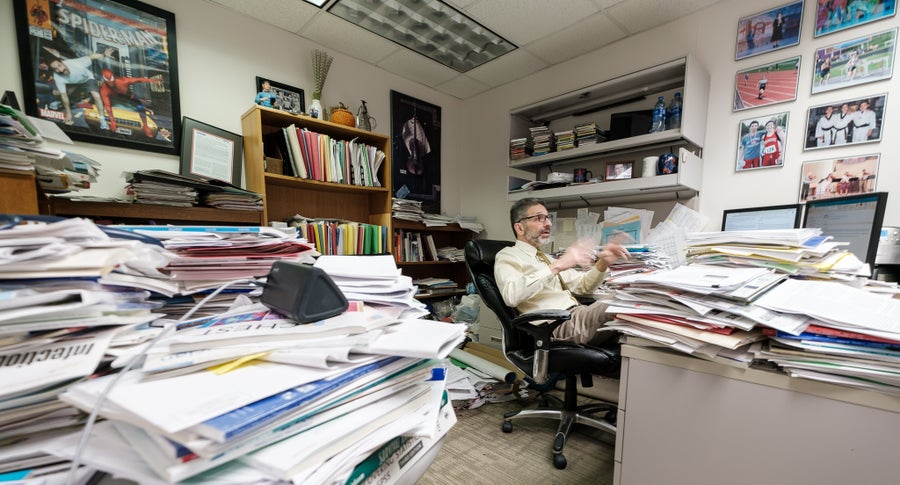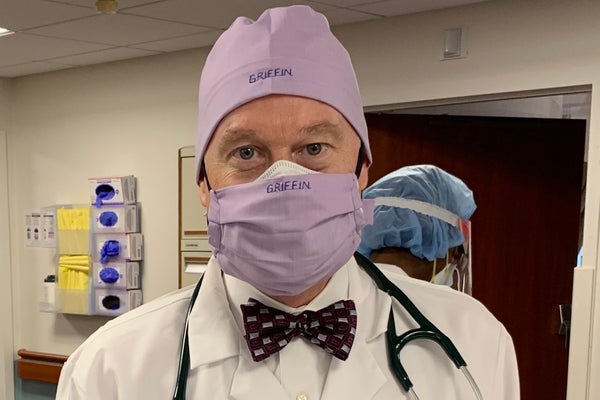Daniel Griffin, an infectious disease specialist, was standing with a group of physicians outside the doors of the intensive care unit at Plainview Hospital on Long Island, N.Y., in late February. Layered in protective gowns, masks, and gloves and standing six feet apart to maintain social distancing, the doctors swapped stories about their COVID-19 patients. Griffin brought up a disturbing trend: Many of his patients seemed on their way to recovery but then relapsed into severe respiratory distress. His colleagues had seen a similar pattern. The fluctuation of symptoms was puzzling for a virus.
Then the doctors had an insight: shortness of breath, chest pain and rapid heart rate are also signs of a pulmonary embolism, a blood clot that lodges in the arteries of the lungs. And unlike the new coronavirus, which everyone was scrambling to understand, blood clots were something they knew how to treat.
The physicians talked about options. Could they put their patients—eight in total—on a full dose of blood thinners? Giving people medication that carries some risk, without solid evidence that clots even existed, seemed capricious. So could the patients go to the radiology department for a scan to look for the clots? During normal times, that would be the logical next step. In the pandemic, however, the radiology team was worried about contamination. The movement of COVID-19 patients around the hospital was discouraged to prevent spreading the virus. But something had to be done. Blood clots kill.
On supporting science journalism
If you're enjoying this article, consider supporting our award-winning journalism by subscribing. By purchasing a subscription you are helping to ensure the future of impactful stories about the discoveries and ideas shaping our world today.
So the doctors came up with a plan to clear out the radiology area, bring all the patients in together for lung scans and then do a deep clean afterward The scans revealed clots that Griffin describes as “dramatic” in seven of the eight patients. Those people were promptly treated with blood thinners, and their symptoms improved. Now all of Griffin’s patients who test positive for COVID-19 and are at risk for clotting are given preventive anticoagulants such as heparin. He has seen fewer embolisms since.
Today, across the U.S., such problem-solving sessions are still happening. They take place in hospital corridors, weekly conference calls, group texts and evening video chats. These conversations are how doctors are dealing with a giant information gap. In nonpandemic times, carefully done clinical trials provide data on a drug’s effectiveness against an illness. Currently, however, compassionate-use programs offer untested treatments; older drugs are considered in never-before-seen situations; research is being rushed into non-peer-reviewed “preprints”; and a constant stream of media reports spotlight any result, often barely vetted.
Doctors have been turning to one another to reduce these unknowns. “The most communication I’ve ever seen in medicine has been occurring in the context of the COVID-19 pandemic,” Griffin says. He has teamed up with friends, many of whom are virology researchers at Columbia University, his home base. They formed an ad hoc journal club to discuss the most clinically relevant research by phone each week. “I rely on my friends. Also, I think I’ve given up sleeping,” Griffin says. Some doctors ask infectious disease specialists to read the scientific literature and e-mail summaries around. Others have group calls. Several small hospitals have weekly updates with staff at large medical centers. Sometimes these informal networks produce a new standard of treatment: At St. Luke’s Hospital, a small community institution in Cedar Rapids, Iowa, doctors who had gone to medical school in New York City heard about Plainview’s positive experience with anticoagulants from former classmates. They are now using the drugs regularly.
But not all doctors agree that experimental treatments or existing drugs used on an unfamiliar disease are worth the risk. Instead they rely largely on traditional life-support therapies, such as added oxygen to help breathing. “Advocating that we should try anything and everything even if it makes a modicum of scientific sense, in my opinion, could be a very dangerous premise,” says G. Marshall Lyon, an infectious disease physician at Emory University. Drugs have risks, and they ultimately may not help more than life-support therapy. Physicians are trying to navigate these murky waters, where right answers are few and far between. And they are searching for ways to help patients whose families often press them hard to do something different, something new, to save a life.
[Read about one day in the life of a coronavirus physician in New York City.]
In late April I sat in on a weekly conference call among 60 or so physicians working at hospitals in the Denver area. The facilities were filling up with patients who needed intensive care or ventilators for breathing assistance, and doctors were looking for ways to relieve life-threatening symptoms.Joseph Forrester, a pulmonologist at the Medical Center of Aurora in Colorado brought up the interim results of a study investigating the potential for a broad-acting antiviral drug. Remdesivir is an experimental medication designed to stop a virus from replicating in the body. The drug was available through several clinical trials at the time, and the Food and Drug Administration’s compassionate-use program. Doctors on the call wanted to know if it would help their patients or if it raised any risks.

Physician Andre Kalil argues that medications in a testing phase belong only in clinical trials. Credit: Taylor Wilson
In the trial Forrester talked about, which was sponsored by National Institute of Allergy and Infectious Diseases, patients who received remdesivir recovered 31 percent faster than those who received a placebo. Those results looked pretty good, he admitted. But he cautioned there was some toxicity. Forrester had one patient who died after taking the drug. The other experimental option was convalescent serum, antibodies that had been taken from the blood of people who have recovered from COVID-19 and might neutralize the virus that causes it. The data from his hospital showed no deaths after receiving the serum.
One physician on the call asked him, “What would your recommendation be?” There was a long pause. “I don’t think anybody knows,” Forrester eventually replied. Later he told me that he does not insist that doctors at his hospital follow specific guidelines for choosing a medication. Instead, Forrester urges them to consider new results and the wishes of the patients and their families. “We have to use our best judgment in what seems to provide a reasonable benefit with minimal toxicity,” he says.
Yet using experimental drugs without guidelines, and outside of a clinical trial, is a serious mistake, argues Andre Kalil, an infectious disease physician at the University of Nebraska Medical Center. Like Emory’s Lyon, he contends that medications in a testing phase belong only in clinical trials. And outside of such studies, doctors need to be extremely cautious. “We are all anxious to find new treatments and save the lives of our patients,” Kalil says. “But ‘do no harm’ has to be the first thing to come to my mind as a clinician.”
COVID-19 is not Kalil’s first deadly infectious disease outbreak. His medical center is home to the Nebraska Biocontainment Unit, one of three places in the U.S. where Ebola patients received care during the 2014 outbreak. Drawing on that experience, Kalil says that carefully controlled clinical trials are the safest option for patients because of the 24/7 monitoring involved. And clinical trials are the only way to obtain actual evidence of whether an experimental treatment is beneficial. At his hospital, he says, he treats patients with “the standard of care”—for COVID-19, which means they receive fluids, electrolytes and additional oxygen. “This is the only thing that we know, for a fact, saves lives,” he adds.
One of Kalil’s biggest regrets after the Ebola outbreak was the lack of proper studies. Several thousands of people were treated with various experimental drugs, but most studies lacked proper comparison groups, so scientists were unable to see whether the drugs were any safer or more effective than other medications—or none at all. The failure left medicine with no proved therapies for the next time Ebola struck.
Treatments that seem promising at first yet do not stand up to the scrutiny of careful science are not exactly anomalies in the field of medicine. The complete ineffectiveness of the antimalarial drug hydroxychloroquine for COVID-19 in several large studies, following its initial hype, is a recent example. “A lot of times in medicine, there are things which make sense. And they seem to work,” Lyon says. “But then, when we ultimately look at them in clinical trials, they are more harmful than they are good.”
Lyon tells me that multiple times during the past few months, he has made the difficult decision to forgo experimental treatments. There were several patients who he was convinced would not make it through the night. They were on mechanical ventilation, with the oxygen flowing at 100 percent. Their kidneys were failing, and their blood pressure was off the charts. Still, he did not try any long-shot drug in these cases. It was not always a popular choice, he recalls. He got pushback from colleagues. In one instance, a hospital physician on duty pleaded with him: “This patient is dying in front of me, how can we not do something?”
“We are doing something,” was Lyon’s reply. “We are breathing for him, correcting electrolytes and maintaining blood pressure. He might not make it despite everything. But doing one more unproved thing is probably not going to turn the tide.” And despite looking as if he was on the brink of death, that patient was alive the next morning and ultimately recovered.
Patients’ families also push doctors to trade evidence for hope. About a month ago, at Plainview Hospital, Griffin’s team got a call from the son of a COVID-19 patient who was being treated in the intensive-care unit. The frantic voice on the other end of the line wanted to know that the doctors were trying everything possible to save his father’s life. At the time, President Donald Trump was touting hydroxychloroquine, urging patients to take it regardless of the unknowns. But the physicians at Plainview did not deem the drug to have enough of a benefit to justify the risk—and that risk was a dangerously abnormal heart rhythm that could kill. “It doesn’t look like its helping people,” the doctor on call tried to explain.
The frustration on the other end of the line escalated with each appeal. Calm medical explanations did nothing to assuage the son’s anxiety. His pain was palpable and quickly erupted into a rage. Griffin remembers him yelling that “if you don’t give my dad that malaria medicine, I’m going to drive my truck through the wall of the hospital and give it to him myself!”
The doctors relented and gave the drug to the father, with the caveat that it was an experiment. The man passed away the next day.
Read more about the coronavirus outbreak from Scientific American here. And read coverage from our international network of magazines here.
